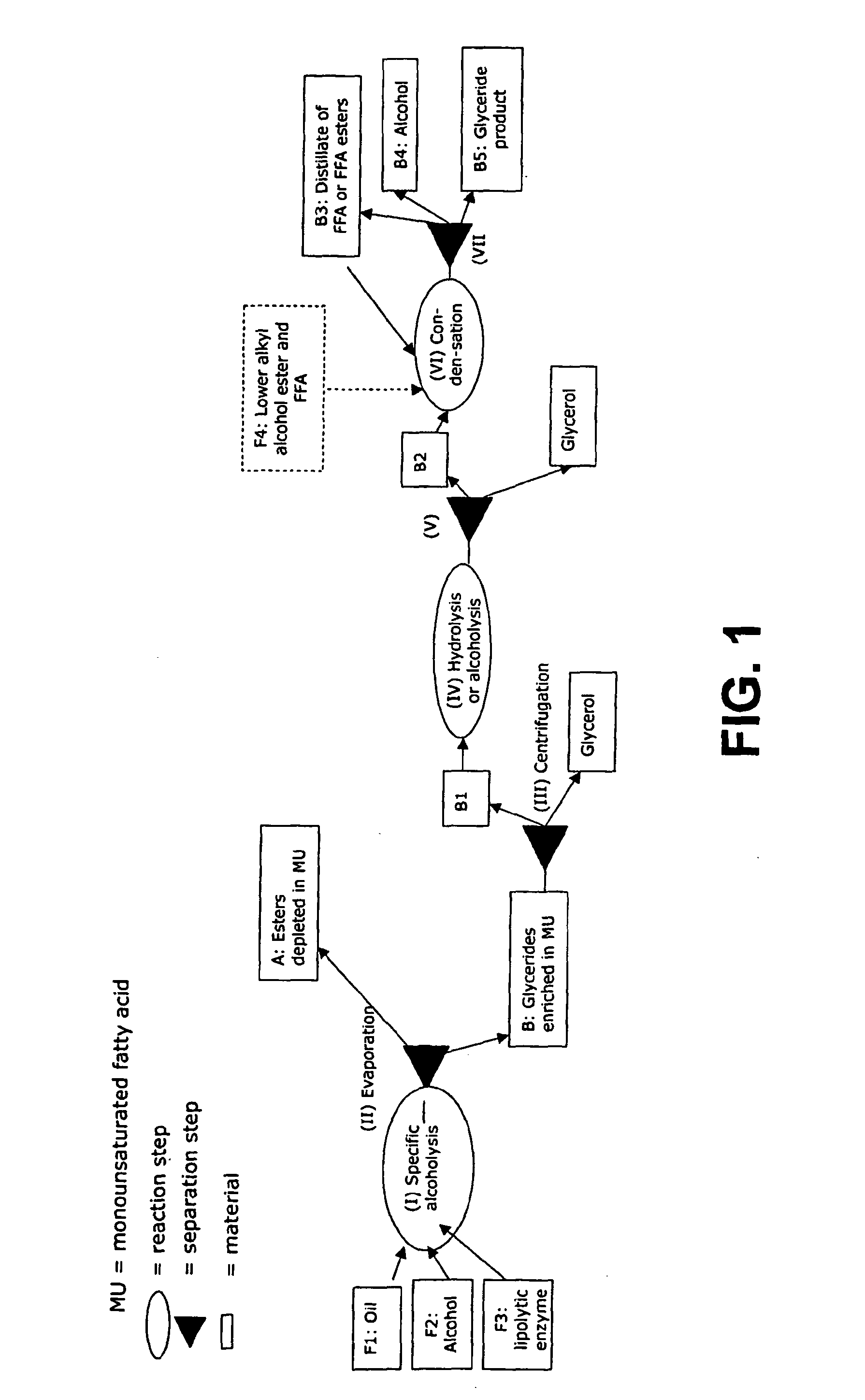Method for Producing Monosaturated Glycerides
a monosaturated glyceride and monosaturated glyceride technology, applied in the field of glycerides, can solve the problems of increasing the risk of cardiac vascular diseases and raising blood cholesterol
- Summary
- Abstract
- Description
- Claims
- Application Information
AI Technical Summary
Problems solved by technology
Method used
Image
Examples
example 1
Specificity Study for Candida Antarctica Lipase A
[0083]The enzyme Candida Antarctica lipase A-Novozym 735-N735 (batch: LDN00026) with an activity of 6KLU was used. The substrates: Palm Stearine (PS); Soybean Oil (SBO); and High Oleic Oil, all purchased from Sigma, was tested
A. Fat Hydrolysis
[0084]1. Weight 200 g of oil into a 500 ml empty screw cap flask.
2. Add 35 g of water into the same flask and keep at oven temperature of 70° C. for one hour.
3. Treat by high shear mixing (IKA Ultra Turrax T25) at 24,000 rpm for 90 seconds.
4. Transfer 100 g of the emulsion to a 250 ml empty screw cap flask.
5. Add in 600 ppm (51 μl) of Novozym 735. The dosage is as per the dry basis of the emulsion.
6. Place the flask in a shaker water bath running at 200 rpm and 70° C.
7. Collect 10 g of sample into a tube after 1, 2, 4, 23 and 24 hours.
8. Keep the tube in a water bath at 80° C. for at least 15 minutes to deactivate the enzyme.
9. Centrifuge the tube at 3500 rpm for 15 minutes to separate the oil fr...
example 2
Process Employing 1,3-Specific Lipolytic Enzymes
[0093]In a process which combine enzyme reactions with separation a glyceride product is produced with an enriched content of monounsaturated fatty acids.
[0094]100 kg palm olein and 7.2 kg ethanol is used as raw material for an enzyme reaction using a 1,3-specific lipolytic enzyme such as e.g. Lipozyme TL IM to produce a mixture of monoglycerides, diglycerides, glycerol, and ethyl esters of fatty acids. The reaction is carried out at a temperature of 40° C. The molar ratio of palm olein to ethanol is 2:1 meaning that for every mole of free fatty acids in the palm olein half a mole ethanol is used. The reaction proceeds until almost all the ethanol has reacted. The enzyme prefers reaction with the 1- and 3-position. The reaction product comprises ethyl esters mainly from saturated fatty acids.
[0095]The mixture is separated by distillation or evaporation into two fractions: (1) an ethyl ester fraction mainly comprising saturated fatty ac...
example 3
Process Employing Lipolytic Enzymes Selective for Saturated Fatty Acids
[0102]In a process which combine enzyme reactions with separation a glyceride product is produced with an enriched content of monounsaturated fatty acids.
[0103]100 kg palm olein and 7.2 kg ethanol is used as raw material for an enzyme reaction using a lipase reacting preferably with the saturated fatty acids such as e.g. Candida antarctica lipase A to produce a mixture of monoglycerides, diglycerides, glycerol, and ethyl esters of fatty acids. The reaction is carried out at a temperature of 40° C. The molar ratio of palm olein to ethanol is 2:1 meaning that for every mole of free fatty acids in the palm olein half a mole ethanol is used. The reaction proceeds until almost all the ethanol has reacted. The reaction product comprises ethyl esters mainly from saturated fatty acids.
[0104]The mixture is separated by distillation or evaporation into two fractions: (1) an ethyl ester fraction mainly comprising saturated ...
PUM
| Property | Measurement | Unit |
|---|---|---|
| temperatures | aaaaa | aaaaa |
| pressures | aaaaa | aaaaa |
| temperatures | aaaaa | aaaaa |
Abstract
Description
Claims
Application Information
 Login to View More
Login to View More - R&D
- Intellectual Property
- Life Sciences
- Materials
- Tech Scout
- Unparalleled Data Quality
- Higher Quality Content
- 60% Fewer Hallucinations
Browse by: Latest US Patents, China's latest patents, Technical Efficacy Thesaurus, Application Domain, Technology Topic, Popular Technical Reports.
© 2025 PatSnap. All rights reserved.Legal|Privacy policy|Modern Slavery Act Transparency Statement|Sitemap|About US| Contact US: help@patsnap.com



